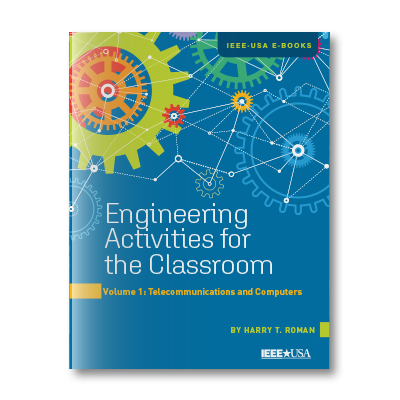

Engineering Activities for the Classroom – Vol. 1: Telecommunications and Computers
FREE to Members
Non-Members: $2.99
Veteran engineer and educator, Harry T. Roman has written a new educational series on Engineering Activities for the Classroom. This new series deals with topics of timely interest in the engineering world, and is designed to get young minds interested in, and excited about, engineering. Teachers can use the activities in these books to develop lesson plans or assignments for students — both in class, and via distance learning.
Volume 1 of this exciting new series focuses on Telecommunications and Computers.
Since he was young, Roman was intrigued with educational books that discussed and showed activities that the reader could do, like experiments, independent research, and making things using one’s hands. That fascination is the inspiration for this book series; as well as the many appearances the author has made in local middle schools — to challenge students to use their head and hands when solving problems. Roman couples this interest with a desire to look at problems from many different vantage points — what he calls “360-degree problem solving.”
“Nothing succeeds better than stimulating students to learn something on their own, or within the context of a team—working cooperatively on a problem or concern, said Roman. “It is the reason for the many questions and activities centered around powerful technological happenings,” he said.
Having been a research program manager and inventor during his engineering career, Roman led many teams of fellow engineers, scientists, economists, and environmental and legal experts on major corporate projects. Those projects all began with problems surfacing; and they developed figuring out how their various aspects came together in an integrated fashion.
Roman designed the activities in this book to get young minds thinking and asking questions — just like his project team members always did before building or prototyping a new product.
“The union of communication and computer technologies has unleashed a huge potential challenge to our world, certainly affecting it for decades to come; and opening tremendous opportunities for beneficial changes, said Roman.
Further, “Traditional organizations will evolve in new ways. Schools and colleges will transform into new centers of learning. The workplace will change; as well as local demographics and economic development, along with it. Our world is evolving into something very different,” he said.
Volume 1 of Engineering Activities for the Classroom contains many activities for students [and teachers] to explore and consider about Telecommunications and Computers. Such activities can be the basis of student team analysis or design; or in anticipation of what a changed world has to offer.
All activities presented require students to research the internet, or other sources, to learn about the possible impacts that could result from new telecommunications-computer relationships. According to Roman, teachers should urge their students to identify and evaluate how these technologies can affect the entire fabric of civilization — from the technical to the economic, environmental, social, political, safety and legal
fibers of this fabric. Encourage them to take a 360-degree look that causes them to integrate both their learning and academic subjects.
Beginning 1 May, IEEE-USA is offering Engineering Activities for the Classroom, Volume 1: Telecommunications and Computers, free to all IEEE members. Non-members pay $2.99
To download, IEEE Members should go to the IEEE-USA Shop and sign in with your IEEE account; add the book to your cart and check out — no special promo code needed for your free download!
Future volumes in this series will focus on Energy in Our World; Engineering; Robotics; and Invention and Entrepreneurship.
Don’t miss this free download to begin your collection of this excellent new series for students. Challenge them, and yourselves. Happy exploring!
Georgia C. Stelluto is IEEE-USA’s Publishing Manager; Manager/Editor of IEEE-USA E-BOOKS; department editor for the InFocus Section of IEEE-USA InSight; and co-editor of the IEEE-USA Conference Brief.






